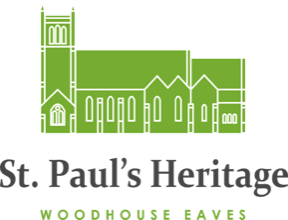
A Matter of Death & Life
in St Paul's Churchyard
by Maggie Morland


Ivy leaved Toadflax on a wall
Look closely - this quiet sanctuary for the dead is also thriving with life. St Paul’s churchyard is a haven for many species of plants and animals that go mostly un-noticed and undisturbed. But pause for a while, listen to the robin singing from the holly, the delicate leaves of lofty lime trees rustling in the breeze or insects buzzing among the wildflowers and ivy. Look for the tiny snapdragon flowers of ivy-leaved toadflax clambering over the stone walls or stroke the rough lichens and velvety mosses encrusting the weathered gravestones. In spring a heavenly scent drifts up from a haze of bluebells on the woodland edge, while in autumn fungi release their own perfume.

Ivy flowers are a vital source of nectar in autumn

One of the many lichens on gravestones
At dusk you may see or hear a nocturnal visitor, pipistrelle bats flitting around the roof tiles, a grunting badger, snuffling hedgehog or the haunting call of a tawny owl.
Trees create atmosphere in the churchyard, and provide shelter, nesting sites for birds and shade. St Paul’s churchyard trees include lime, oak, holly, privet, pine and yew. Yews are only native in Britain on chalk and limestone, so most have been planted deliberately. Traditionally a symbol of immortality, resurrection and protection from evil, yews were commonly planted by the lych-gate, priests meeting the coffins by the yew tree. The yew avenue from the lych-gate to the West door at St Paul’s protects visitors both literally and symbolically.

The yew avenue leading to the lych-gate